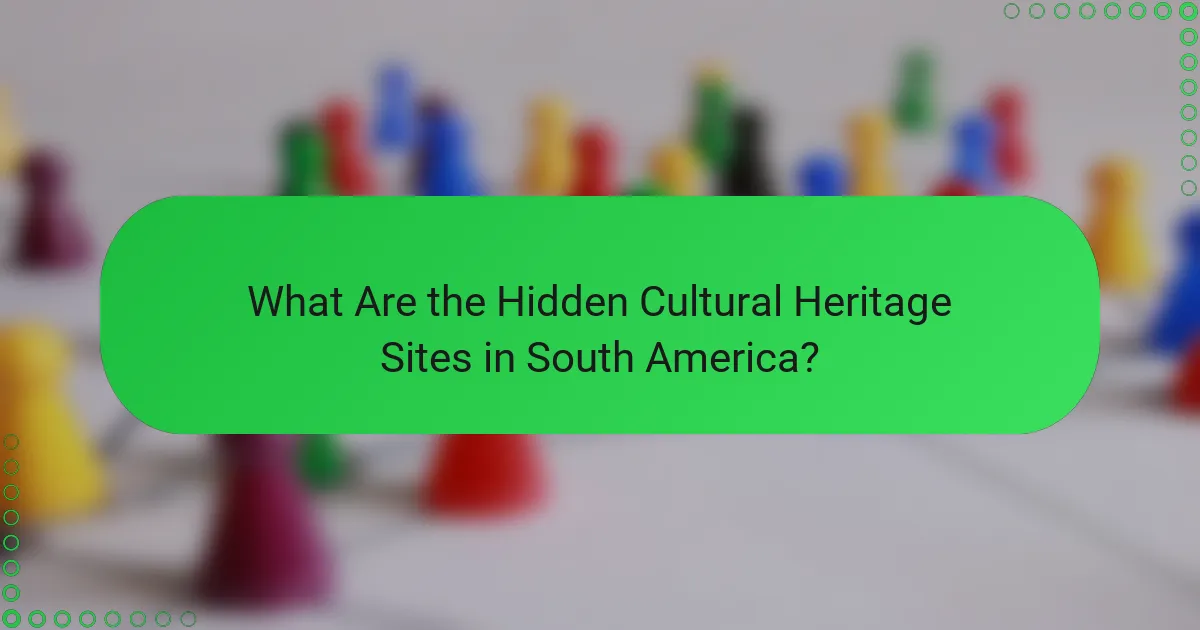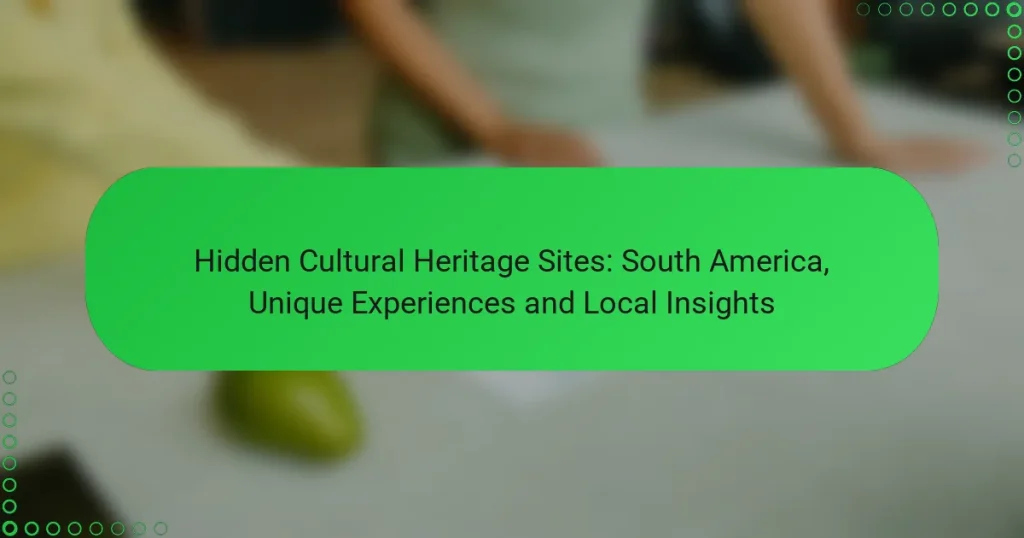Hidden cultural heritage sites in South America offer travelers a chance to explore the continent’s rich history and diverse cultures beyond the typical tourist paths. By engaging with local communities and participating in traditional activities, visitors can gain authentic insights into ancient civilizations and vibrant local traditions. These unique experiences, from traditional festivals to culinary adventures, reveal the intricate tapestry of South America’s cultural heritage.

What Are the Hidden Cultural Heritage Sites in South America?
Hidden cultural heritage sites in South America are lesser-known locations that offer unique insights into the continent’s rich history and diverse cultures. These sites often provide immersive experiences that showcase ancient civilizations, architectural marvels, and local traditions, making them invaluable for travelers seeking authentic encounters.
Inca Trail, Peru
The Inca Trail is a renowned trekking route leading to the ancient city of Machu Picchu, but it also offers access to lesser-known Incan ruins along the way. This multi-day hike typically takes four days and showcases stunning landscapes, diverse ecosystems, and rich cultural heritage. Permits are required and should be booked well in advance, especially during the peak season from May to September.
Travelers should prepare for varying weather conditions and consider hiring a local guide to enhance their experience. Be mindful of altitude sickness, as the trail reaches elevations over 4,200 meters.
Tiwanaku, Bolivia
Tiwanaku is an archaeological site near Lake Titicaca, known for its impressive stone structures and monolithic sculptures. This ancient city was a significant cultural center for the Tiwanaku civilization, which thrived between 300 and 1000 AD. Visitors can explore the Temple of Kalasasaya and the Gateway of the Sun, which showcase advanced engineering and astronomical alignments.
When visiting, consider joining a guided tour to gain deeper insights into the site’s history and significance. The site is accessible from La Paz, making it a convenient day trip.
Chavín de Huantar, Peru
Chavín de Huantar is an archaeological site that dates back to around 900 BC and is considered one of the oldest ceremonial centers in Peru. The site features intricate stone carvings and a complex network of underground galleries. It played a crucial role in the development of Andean culture and religion.
Travelers can reach Chavín de Huantar from Huaraz, and guided tours often include visits to nearby hot springs. Be prepared for a high-altitude environment and plan for potential weather changes.
Qhapaq Ñan, South America
The Qhapaq Ñan, or Inca Road System, is a vast network of ancient roads that connected the Inca Empire across several countries, including Peru, Ecuador, Bolivia, and Argentina. This UNESCO World Heritage site spans thousands of kilometers and offers various hiking routes that showcase breathtaking landscapes and historical landmarks.
Travelers can explore different sections of the road, each with unique features and cultural significance. It’s advisable to research specific trails and their accessibility, as some areas may require permits or local guides.
Ciudad Perdida, Colombia
Ciudad Perdida, or the Lost City, is an ancient archaeological site nestled in the Sierra Nevada mountains of Colombia. Believed to have been founded around 800 AD, it features terraced structures and intricate stone pathways. The site is accessible through a challenging multi-day trek, making it a rewarding adventure for those willing to undertake the journey.
Guided tours are essential for visiting Ciudad Perdida, as they provide safety and context about the site’s history. Travelers should be prepared for humid conditions and varying terrain, and it’s best to visit during the dry season from December to March.

How Can You Experience These Sites Authentically?
To experience hidden cultural heritage sites in South America authentically, engage with local communities and participate in activities that reflect their traditions and lifestyles. This approach fosters a deeper understanding and appreciation of the cultural significance of these sites.
Local guided tours
Local guided tours offer an excellent way to explore hidden cultural heritage sites while gaining insights from knowledgeable residents. These tours often include stories and perspectives that you won’t find in guidebooks, enhancing your experience. Look for tours that are led by local experts who can provide context and share personal anecdotes.
When selecting a tour, consider the size of the group; smaller groups often allow for more interaction and personalized experiences. Prices can vary widely, typically ranging from $20 to $100 per person depending on the location and length of the tour.
Cultural immersion programs
Cultural immersion programs provide an opportunity to live and learn within a community, allowing for a more profound connection to the local culture. These programs may include homestays, cooking classes, or workshops in traditional crafts. Participants often engage in daily life activities, which can lead to lasting friendships and a richer understanding of local customs.
Costs for cultural immersion programs can vary, often starting around $300 for a week-long experience, including accommodation and meals. Research different programs to find one that aligns with your interests and budget.
Community-based tourism
Community-based tourism focuses on sustainable travel that benefits local communities directly. This approach often involves staying in locally-owned accommodations and participating in community-led activities. It allows travelers to contribute to the local economy while experiencing authentic cultural practices.
When considering community-based tourism, look for initiatives that prioritize environmental sustainability and cultural preservation. Prices can be competitive with traditional tourism options, often ranging from $50 to $150 per night for accommodations, depending on the location and amenities offered.

What Unique Experiences Do These Sites Offer?
Hidden cultural heritage sites in South America provide unique experiences that immerse visitors in local traditions, history, and artistry. These experiences often include participation in traditional festivals, hands-on archaeological workshops, and authentic culinary adventures that highlight the region’s rich cultural tapestry.
Traditional festivals
Participating in traditional festivals allows visitors to experience the vibrant culture of South America firsthand. Events such as Inti Raymi in Peru or Carnival in Brazil showcase local music, dance, and rituals that have been passed down through generations.
These festivals often feature colorful parades, traditional costumes, and local food stalls. Engaging with the community during these celebrations can provide insights into the region’s history and social dynamics.
Archaeological workshops
Archaeological workshops offer hands-on experiences where visitors can learn about ancient civilizations and their practices. Many sites, such as those in Ecuador or Bolivia, provide opportunities to participate in excavation or restoration projects, guided by local experts.
These workshops not only educate participants about historical techniques but also emphasize the importance of preserving cultural heritage. Expect to spend a few hours to a couple of days, depending on the program, and be prepared for a mix of physical activity and intellectual engagement.
Local culinary experiences
Local culinary experiences invite visitors to explore the diverse flavors of South American cuisine through cooking classes or food tours. Participants can learn to prepare traditional dishes like ceviche in Peru or feijoada in Brazil, often using locally sourced ingredients.
These culinary adventures can range from informal street food tastings to formal cooking classes in local homes. Engaging with local chefs and families not only enhances cooking skills but also fosters a deeper appreciation for the region’s culinary heritage.

What Are the Benefits of Visiting Hidden Cultural Heritage Sites?
Visiting hidden cultural heritage sites offers unique experiences that enrich travelers while supporting local communities. These sites often provide a deeper understanding of a region’s history and traditions, fostering appreciation for diverse cultures.
Support for local economies
Exploring lesser-known cultural heritage sites can significantly boost local economies. When travelers visit these areas, they contribute to the income of local businesses such as restaurants, shops, and accommodations.
For example, a small village in Peru may rely on tourism to sustain its economy. By spending money on local crafts or dining at family-owned eateries, visitors help create jobs and promote economic stability.
Preservation of cultural heritage
Hidden cultural heritage sites often face threats from modernization and neglect. By visiting these locations, tourists play a crucial role in their preservation, as increased interest can lead to funding for maintenance and restoration efforts.
For instance, supporting a lesser-known archaeological site in Colombia can help ensure that its artifacts and structures are protected for future generations. Local governments may allocate resources for preservation when they see a rise in visitor numbers.
Enhanced personal enrichment
Traveling to hidden cultural heritage sites provides opportunities for personal growth and learning. Engaging with local customs and traditions can broaden perspectives and foster a deeper appreciation for cultural diversity.
Participating in traditional festivals or workshops, such as weaving in Ecuador, allows travelers to gain hands-on experience and connect with the community. These enriching experiences often lead to lasting memories and a greater understanding of the world.

How to Choose the Right Course for Exploring Cultural Heritage?
Selecting the right course for exploring cultural heritage involves understanding your interests, the course content, and the teaching methods. Focus on programs that offer immersive experiences and local insights to enhance your appreciation of South America’s rich cultural tapestry.
Course content relevance
When evaluating a course, consider how closely the content aligns with your interests in cultural heritage. Look for programs that cover specific regions or themes, such as indigenous cultures, colonial history, or contemporary practices. Courses that include hands-on activities, like workshops or site visits, can provide practical insights.
Check if the course offers a balance between theoretical knowledge and experiential learning. For instance, a program that combines lectures with field trips to lesser-known sites in Peru or Brazil can deepen your understanding of local customs and traditions. This approach often leads to a more enriching experience.
Additionally, consider the expertise of the instructors. Courses led by local experts or cultural practitioners can offer unique perspectives and insider knowledge that enhance your learning. Look for reviews or testimonials from past participants to gauge the effectiveness of the course content.


